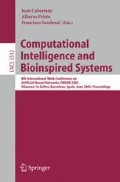Abstract
In stereoscopic vision, there are two artificial eyes implemented so that it can obtain two separate views of the scene and simulate the binocular depth perception of human beings. Traditionally, camera calibration and 3D reconstruction of such a vision sensor are performed by geometrical solutions. However, the traditional camera model is very complicated since nonlinear factors in it and needs to approximate the light projection scheme by a number of parameters. It is even very difficult to model some highly distorted vision sensors, such as fish-eye lens. In order to simplify both the camera calibration and 3D reconstruction procedures, this work presents a method based on neural networks which is brought forward according to the characteristics of neural network and stereoscopic vision. The relation between spatial points and image points is established by training the network without the parameters of the cameras, such as focus, distortions besides the geometry of the system. The training set for our neural network consists of a variety of stereo-pair images and corresponding 3D world coordinates. Then the 3D reconstruction of a new s cene is simply using the trained network. Such a method is more similar to how human’s eyes work. Simulations and real data are used to demonstrate and evaluate the procedure. We observe that the errors obtained our experimentation are accurate enough for most machine-vision applications.
This work is supported by the National Natural Science Foundation of China (NSFC No. 60405009 and 60374056) and Zhejiang Natural Science Foundation of China (ZJNSF No.Y104185).
Access this chapter
Tax calculation will be finalised at checkout
Purchases are for personal use only
Preview
Unable to display preview. Download preview PDF.
References
Weng, J., Cohen, P., Herniou, M.: Camera calibration with distortion models and accuracy evaluation. IEEE Transactions on Pattern Analysis and Machine Intelligence, 965–980 (1992)
Tsai, R.Y.: An efficient and accurate camera calibration technique for 3D machine vision. In: International Conference on Computer Vision and Pattern Recognition, pp. 364–374 (1986)
Zhang, Z.: A flexible new technique for camera calibration. IEEE Transactions on Pattern Analysis and Machine Intelligence 22(11), 1330–1334 (2000)
Qing, G.W., Hrizinger, G.: Multisensory Visual Servoing by a Neural Networks. IEEE Transactions on Systems. Man and Cybernetics (1999)
Zhao, Q.J., Sun, Z.X., Lan, L.: Camera calibration technology using neural network. Control and Decision-making 17(13) (2002)
Chen, S.Y., Li, Y.F.: Automatic Sensor Placement for Model-Based Robot Vision. IEEE Transactions on Systems, Man and Cybernetics, Part B 34(1), 393–408 (2004)
Li, Y.F., Chen, S.Y.: Automatic Recalibration of an Active Structured Light Vision System. IEEE Transactions on Robotics and Automation 19(2), 259–268 (2003)
Weng, J., Cohen, P., Herniou, M.: Camera calibration with distortion models and accuracy evaluation. IEEE Trans. on Pattern Analysis and Machine Intelligence 14(10), 965–980 (1992)
Thormählen, T., Broszio, H., Wassermann, I.: Robust Line-Based Calibration of Lens Distortion from a Single View. In: Proc. of Mirage 2003, INRIA Rocquencourt, France, pp. 105-112 (2003)
Author information
Authors and Affiliations
Editor information
Editors and Affiliations
Rights and permissions
Copyright information
© 2005 Springer-Verlag Berlin Heidelberg
About this paper
Cite this paper
Wang, Wl., Xia, Bb., Guan, Q., Chen, S. (2005). Neural Network Based 3D Model Reconstruction with Highly Distorted Stereoscopic Sensors. In: Cabestany, J., Prieto, A., Sandoval, F. (eds) Computational Intelligence and Bioinspired Systems. IWANN 2005. Lecture Notes in Computer Science, vol 3512. Springer, Berlin, Heidelberg. https://doi.org/10.1007/11494669_81
Download citation
DOI: https://doi.org/10.1007/11494669_81
Publisher Name: Springer, Berlin, Heidelberg
Print ISBN: 978-3-540-26208-4
Online ISBN: 978-3-540-32106-4
eBook Packages: Computer ScienceComputer Science (R0)

